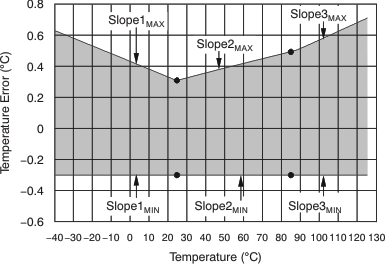SLOS887F September 2014 – June 2022 TMP112-Q1
PRODUCTION DATA
- 1 Features
- 2 Applications
- 3 Description
- 4 Revision History
- 5 Description (continued)
- 6 Pin Configuration and Functions
- 7 Specifications
-
8 Detailed Description
- 8.1 Overview
- 8.2 Functional Block Diagram
- 8.3 Feature Description
- 8.4 Device Functional Modes
- 8.5 Programming
- 9 Application and Implementation
- 10Power Supply Recommendations
- 11Layout
- 12Device and Documentation Support
- 13Mechanical, Packaging, and Orderable Information
Package Options
Mechanical Data (Package|Pins)
- DRL|6
Thermal pad, mechanical data (Package|Pins)
Orderable Information
9.1.1 Calibrating for Improved Accuracy
Many temperature monitoring applications require better than 0.5°C accuracy over a limited temperature range. Knowing the offset of a temperature sensor at a given temperature in conjunction with the average temperature span (slope) error over a fixed range makes achieving this improved accuracy possible.
The TMP112-Q1 device has three distinct slope regions that conservatively approximate the inherent curvature. The following lists the three distinct slope regions:
- Slope1 applies over –40°C to 25°C
- Slope2 applies over 25°C to 85°C
- Slope3 applies over 85°C to 125°C
The Section 7.6 table defines these slopes which are also shown in Figure 9-1.
Each slope listed in the Section 7.6 table is increasing with respect to 25°C.
 Figure 9-1 Accuracy and Slope Curves versus Temperature
Figure 9-1 Accuracy and Slope Curves versus TemperatureUse Equation 1 to calculate the worst-case accuracy at a specific temperature.
